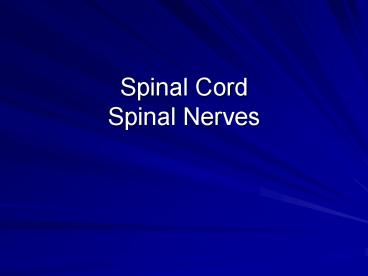Spinal Cord Spinal Nerves - PowerPoint PPT Presentation
1 / 32
Title:
Spinal Cord Spinal Nerves
Description:
... innervation of diaphragm Brachial plexus Brachial plexus Axillary nerve Radial nerve Musculocutaneous nerve Median nerve Ulnar nerve Brachial plexus Lumbar ... – PowerPoint PPT presentation
Number of Views:227
Avg rating:3.0/5.0
Title: Spinal Cord Spinal Nerves
1
Spinal CordSpinal Nerves
2
Spinal Cord
- Part of the CNS
- About 18 inches long
- Extends from the foramen magnum to the end of L1
- Main pathway for information flow to and from the
brain
3
Spinal Cord Histology / Structure
4
Dorsal root ganglia
- Sensory neuron cells bodies
- These are unipolar neurons in structure
5
Gross Anatomy of the Spinal Cord
- Cord is divided into cervical, thoracic, lumbar
and sacral segments - Cervical and lumbar enlargements
- Covered by same membranes as the brain
- At about L1 the cord divides into many long
ventral and dorsal roots called the cauda equina
(horses tail) - Each spinal segment has a pair of dorsal root
ganglia (sensory neuron cell bodies) - Dorsal root enters the cord, ventral root leaves
the cord
6
(No Transcript)
7
Spinal cord and meninges
8
Spinal Cord and Meninges
9
Ganglia and roots
- Dorsal root ganglia sensory neuron cell bodies
- Dorsal root sensory input
- Ventral root motor output
- Spinal nerve - mixed
10
Epidural analgesia
- Pain medication placed into the epidural space
- Often used to block pain associated with child
birth - Continuous infusion
- Blocks pain not muscle activity
11
Spinal Cord White Matter
- White matter is divided into columns
- Columns contain TRACTS composed of axons of
similar structural and functional characteristics - Specific tracts convey either sensory or motor
commands - All axons in a tract relay information in the
same direction - ASCENDING TRACTS relay sensory information toward
the brain - DESCENDING TRACTS relay motor information into
the spinal cord
12
Spinal Cord Gray Matter
- Gray matter is organized into nuclei neuron
cell bodies - Sensory nuclei receive and relay sensory
information - Motor nuclei send out commands to peripheral
effectors, skeletal muscles
13
(No Transcript)
14
Spinal Nerves
- 31 pairs of spinal nerves
- C1-C8
- T1-T12
- L1-L5
- S1-S5
15
Nerve Structure
- Nerve is divided into fascicles
- Outer covering of the nerve is the epineurium
- Each fascicle is surrounded by the perineurium
- Each axon in the fascicle is covered by the
endoneurium
16
Nerve Distribution - motor
17
Nerve Distribution - sensory
18
Spinal Cord Injuries
- Two general types of injuries
- Complete - no function below the affected area of
the cord - C1 - C3 injury breathing affected - respirator
- C4 - C7 quadriplegia (arms and legs)
- Incomplete - some function below the affected
area of the cord - Thoracic area and below - paraplegia (legs)
19
Cause of Spinal Cord Injuries
- Sudden traumatic blow to spine that fractures or
dislocates vertebrae - Bone fragments, disc material bruise or tear the
spinal cord tissue - Cord swells, blood supply cells can stop, neurons
die, cord is damaged beyond repair
20
Treatment of Spinal Cord Injuries
- Minimize further injury
- Realign spine and immobilize (surgery)
- Steroid medication to reduce swelling
- Methylprednisolone in first 8 hours reduces
swelling, inflammation and nerve cell damage - Rehabilitation
- Dealing with long term complications
21
Nerve Plexuses
- Ventral rami (branches) of various spinal nerves
blend together to form an interwoven network of
nerves, nerve plexus - Four major plexuses
- Cervical
- Brachial
- Lumbar
- Sacral
22
(No Transcript)
23
(No Transcript)
24
Cervical Plexus
25
Cervical plexus
- Ventral rami of C1-C4 with a few fibers from C5
- Innveration of muscles of the neck, shoulder and
upper breast - Phrenic nerve innervation of diaphragm
26
Brachial plexus
27
Brachial plexus
- Axillary nerve
- Radial nerve
- Musculocutaneous nerve
- Median nerve
- Ulnar nerve
28
Brachial plexus
29
Lumbar plexus and Sacral plexus
30
Major spinal nerves from the lumbar and sacral
plexus
31
Nerves of the lower extermity
32
Reflex arc































